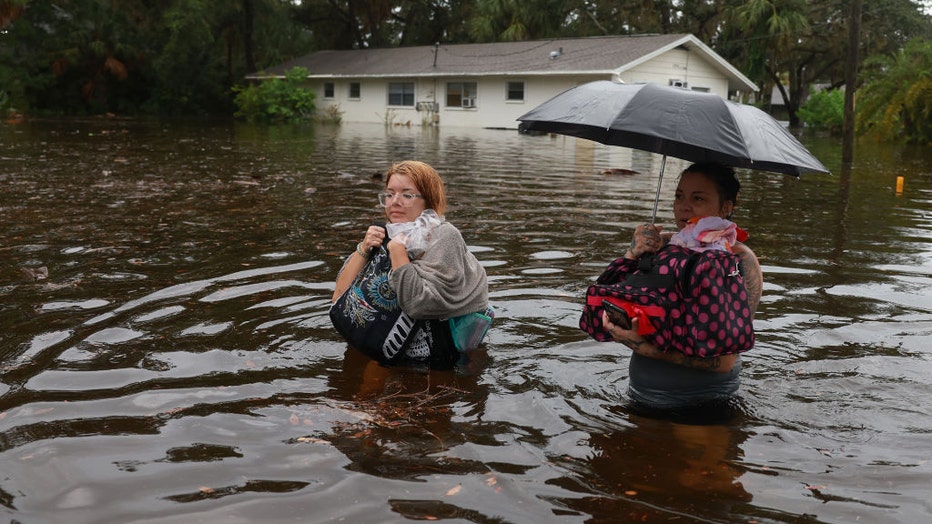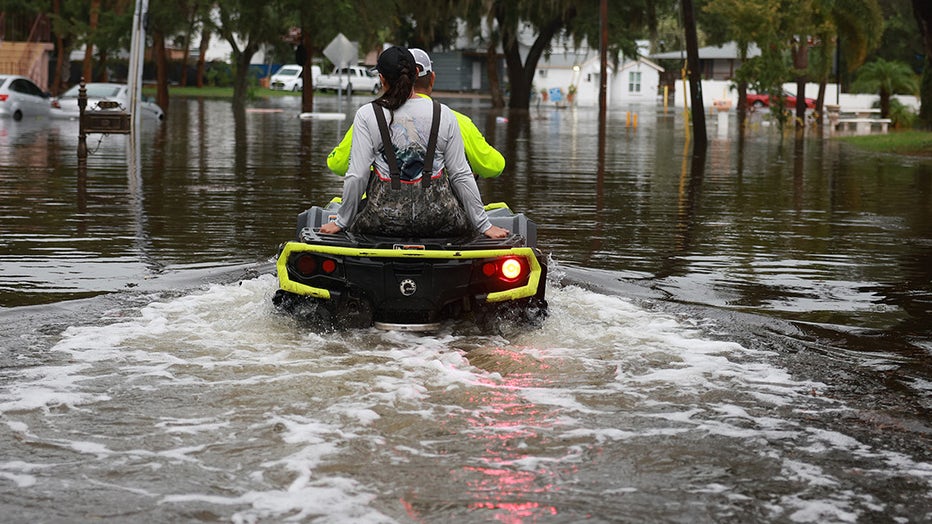Idalia downgraded to tropical storm over Georgia after making Florida landfall
CEDAR KEY - Idalia has been downgraded to a tropical storm as it passes over Georgia.
The National Hurricane Center’s latest advisory says the storm was centered west of Savannah, Georgia, on Wednesday near Pembroke and had maximum sustained winds of 70 mph. Hurricane force winds are at least 74 mph.
Hurricane Idalia remained an extremely dangerous Category 2 hurricane as it moved into Georgia after making landfall Wednesday morning on Florida’s west coast, where it unleashed life-threatening storm surges and rainfall across an area that has never before received such pummeling.
More than 242,000 customers were without electricity as trees snapped by strong winds brought down power lines and rushing water covered streets. Along the coast, some homes were submerged to near their rooftops and structures crumpled. As the eye moved inland, destructive winds shredded signs and sent sheet metal flying.
RELATED: Hurricane Idalia: Monitoring power outages across Tampa Bay area
"We have multiple trees down, debris in the roads, do not come," posted the fire and rescue department in Cedar Key, where a tide gauge measured the storm surge at 6.8 feet (2 meters), submerging most of the downtown. "We have propane tanks blowing up all over the island."
Idalia came ashore in the lightly populated Big Bend region, where the Florida Panhandle curves into the peninsula. It made landfall near Keaton Beach at 7:45 a.m. as a high-end Category 3 hurricane with maximum sustained winds near 125 mph (205 kph).
Idalia update and Tampa Bay forecast
FOX 13 Meteorologist Paul Dellegatto breaks down the Wednesday night forecast and what lies ahead following Hurricane Idalia.
It remained a Category 2 hurricane with top winds of 105 mph (165 mph) at 10 a.m., and it was expected to remain a hurricane after crossing Florida east of Tallahassee. Just south of Valdosta, Georgia, Interstate 75 was closed after power lines fell across the highway. Forecasters said it would punish the Carolinas overnight as a tropical storm. Some models predicted Idalia could circle southward toward land again after that, but the National Hurricane Center forecast it to move deeper into the Atlantic this weekend.
RELATED: Hurricane Idalia updates: Flooding, damage in Tampa Bay Area
Astounded by the flooding that turned Tampa's Bayshore Boulevard into a river, Bill Hall watched a paddleboarder ride along the major thoroughfare.
"This is actually unbelievable," Hall said. "I haven’t seen anything like this in years."
Florida man paddles down Bayshore Boulevard
There was some traffic on Bayshore Boulevard this morning, just not the usual kind. With the waterfront road flooded by Hurricane Idalia, this paddleboarder made his way through. Video by FOX 13's Matthew McClellan.
In Tallahassee, Florida's capital city, the power went out well before the center of the storm arrived.
Tallahassee Mayor John Dailey urged everyone to shelter in place — it was too late to risk going outside. Florida residents living in vulnerable coastal areas had been ordered to pack up and leave as Idalia gained strength in the warm waters of the Gulf of Mexico.
"Don’t put your life at risk by doing anything dumb at this point," Gov. Ron DeSantis said at a news conference Wednesday morning. "This thing’s powerful. If you’re inside, just hunker down until it gets past you."

Storm surge could rise as high as 16 feet (4.9 meters) in some places. Some counties implemented curfews to keep residents off roads.
"For those who have chosen to remain on the beaches despite the mandatory evacuation order, please restrict your water and toilet usage," the city of Clearwater posted. "Due to flooding, the city’s lift stations and stormwater system are under strain."
RELATED: Hurricane Idalia updates: Flooding, damage in Tampa Bay Area
Diane Flowers was sound asleep at 1 a.m. Wednesday in her Wakulla County home, but her husband was up watching the weather on TV, and got a text from their son when the storm was upgraded to a Category 4. He's a firefighter/EMT in Franklin County, which is also along the Gulf Coast.
"He said, ‘You guys need to leave,’" Flowers said. "And he’s not one for overreacting, so when he told us to leave, we just packed our stuff, got in our car and got going."
They quickly packed a few clothes, medicine, dog food for their two border collies, a computer, important documents and a bag of Cheetos. Motels were packed all the way into Alabama, where they ended up finding a room in Dothan.
Hurricane Idalia impacts in Florida's Big Bend
FOX Correspondent Grady Trimble reports from Old Town, Florida, as Hurricane Idalia leaves Florida's Big Bend with flooding, storm surge.
The National Weather Service in Tallahassee called Idalia "an unprecedented event" since no major hurricanes on record have ever passed through the bay abutting the Big Bend. The state, still dealing with lingering damage from last year’s Hurricane Ian, feared disastrous results.
But not everyone heeded the warnings.
Andy Bair, owner of the Island Hotel on Cedar Key, said he intended to "babysit" his bed-and-breakfast, which predates the Civil War. The building has not flooded in the almost 20 years he has owned it, not even when Hurricane Hermine flooded the city in 2016.
"Being a caretaker of the oldest building in Cedar Key, I just feel kind of like I need to be here," Bair said. "We’ve proven time and again that we’re not going to wash away. We may be a little uncomfortable for a couple of days, but we’ll be OK eventually."

Makatla Ritchter (L) and her mother, Keiphra Line wade through flood waters after having to evacuate their home when the flood waters from Hurricane Idalia inundated it on August 30, 2023 in Tarpon Springs, Florida. Hurricane Idalia is hitting the Bi
RELATED: Hurricane Idalia updates: Flooding, damage in Tampa Bay Area
Idalia had grown into a Category 2 system on Tuesday afternoon and became a Category 3 just hours earlier Wednesday before strengthening to a Category 4 and then weakening slightly to a high-end Category 3.
Hurricanes are measured on a five category scale, with a Category 5 being the strongest. A Category 3 storm is the first on the scale considered a major hurricane and the National Hurricane Center says a Category 4 storm brings "catastrophic damage."
Tolls were waived on highways out of the danger area and shelters were opened. More than 30,000 utility workers were gathering to make repairs as quickly as possible in the hurricane’s wake. About 5,500 National Guard troops were activated.

People ride an ATV through the flooded streets caused by Hurricane Idalia passing offshore on August 30, 2023 in Tarpon Springs, Florida. (Photo by Joe Raedle/Getty Images)
In Tarpon Springs, on the coast northwest of Tampa, 60 patients were evacuated from a hospital after warnings of a potential 7-foot (2.1-meter) storm surge there.
Both Georgia Gov. Brian Kemp and South Carolina Gov. Henry McMaster announced states of emergency, freeing up state resources and personnel, including hundreds of National Guard troops.
"We’ll be prepared to the best of our abilities," said Russell Guess, who was topping off the gas tank on his truck in Valdosta, Georgia. His co-workers at Cunningham Tree Service were doing the same. "There will be trees on people’s house, trees across power lines."
Asked about the hurricane Tuesday, President Joe Biden said he had spoken to DeSantis and "provided him with everything that he possibly needs."
Ian was responsible last year for almost 150 deaths. That Category 5 hurricane damaged 52,000 structures, nearly 20,000 of which were destroyed or severely damaged.
The National Oceanic and Atmospheric Administration recently said the 2023 hurricane season would be far busier than initially forecast, partly because of extremely warm ocean temperatures. The season runs through Nov. 30, with August and September typically the peak.
___
Associated Press writers Brendan Farrington in Tallahassee, Florida; Mike Schneider in St. Louis, Missouri; Marcia Dunn in Cape Canaveral, Florida; Curt Anderson in Orlando, Florida; Chris O’Meara in Clearwater, Florida; Cristiana Mesquita in Havana; Russ Bynum in Savannah, Georgia; Jeffrey Collins in Columbia, South Carolina; Seth Borenstein in Washington; Kathy McCormack in Concord, New Hampshire; Tara Copp in Washington; and Julie Walker in New York contributed to this report.

